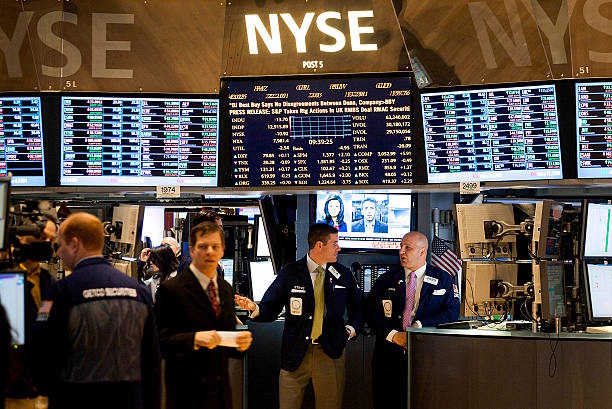
On Friday, stocks concluded the trading session with a mixed performance, as investors persist in disregarding apprehensions regarding the potential government shutdown. The Dow concluded the trading session with an increase of 239 points, representing a 0.51% gain, following a peak rise of 530 points earlier in the day. The S&P 500 exhibited minimal movement, concluding the session with a modest increase of 0.01%. Meanwhile, the tech-heavy Nasdaq Composite experienced a decline of 0.28%. Recent weeks have seen an upward movement in stocks, driven by robust corporate earnings, growing enthusiasm surrounding artificial intelligence, and optimistic expectations regarding potential Federal Reserve rate cuts.
The Dow propelled the market upward on Friday, as the rally expanded to previously neglected sectors, while investors in technology took the opportunity to realize some gains. The Dow and S&P 500 achieved new record highs. Historical evidence indicates that stock markets typically remain resilient during shutdowns, as these events are often brief and exert negligible long-term impacts on economic performance. “History essentially says that government shutdowns have been more headline events than bottom-line-affecting events,” stated Sam Stovall. While the Dow appears to be overlooking prevailing concerns, Wall Street is concurrently grappling with a government data blackout that has deprived investors of the customary gold-standard indicators reflecting the economy’s health. The essential monthly employment report from the Bureau of Labor Statistics was not released on Friday and is included in the data that will be postponed until the conclusion of the government shutdown. The absence of government data presents a challenge for investors, economists, and policymakers, obscuring their understanding of the economy during a pivotal time marked by rising concerns regarding a deteriorating labor market and persistent inflationary pressures.
Should the shutdown persist, the absence of government data may hinder investors’ comprehension of the labor market’s condition and the trajectory of inflation, particularly when equities are historically valued at high levels and susceptible to unforeseen developments. “There’s no opportune moment for a shutdown, but this instance is especially poorly timed. The lack of updated labor data coincides with other signs of fragility in the economy,” said Mark Hamrick. Government agencies, and Census Bureau have announced a delay in the publication of data until the conclusion of the shutdown. “It generates an uptick in uncertainty, because we’re not getting the consistent economic clues that we’re used to,” stated José Torres. The Dow and S&P 500 achieved record highs on the initial three days of the shutdown. The Dow, S&P, and Nasdaq concluded the week with increases exceeding 1%. Nonetheless, risks persist: The lack of the jobs report and the possibility of insufficient information in the future introduce a new dimension of uncertainty to markets and complicate the Federal Reserve’s assessment of the economy. “It is more difficult than usual to measure the state of the US labor market, with gold-standard economic indicators produced by the federal government unavailable during the shutdown,” stated Bill Adams. The risks associated with the shutdown escalate as it persists, as noted by Keith Buchanan. “We just feel like the market is exhibiting an excessive level of optimism,” Buchanan said. “We believe the market underestimates the potential for a more persistent and contentious shutdown.” The monthly jobs report from the Bureau of Labor Statistics was not released on Friday due to the government shutdown, resulting in a delay that will persist until the resolution of the shutdown.
The monthly jobs report from the Bureau of Labor Statistics was not released on Friday due to the government shutdown, resulting in a delay that will persist until the resolution of the shutdown.
Investors and economists find themselves reliant on alternative data sources to gain insights into the economy. In the context of the labor market, insights from private payrolls firm ADP serve as a valuable resource for investors. Data released by ADP on Wednesday indicated that the private sector experienced a reduction of 32,000 jobs in September. This prompted traders to increase their expectations for a Federal Reserve rate cut in October, thereby enhancing stock market performance. Nonetheless, this indicates a decline in the labor market over the past few months, and in the absence of government data, Wall Street will lack the monthly measure of the unemployment rate. “Economists now lack official economic data from the US,” stated Paul Donovan. “Private sector data is a poor substitute,” Donovan stated. Private data is akin to observing the economy through a keyhole — it offers clarity, yet presents a limited perspective. Official data serves as a gateway to understanding. A prominent US flag is displayed on the facade of the Department of Labor headquarters in Washington DC, observed on September 8. Today, there is no jobs report available. Here is what we understand regarding the US labor market. Paul Christopher, indicated in a note that he is advising clients to overlook apprehensions regarding the shutdown. “The duration of the shutdown remains uncertain; however, our guidance continues to focus on the underlying factors we anticipate will drive the economy and investment returns over the next 12-15 months,” Christopher stated.
Catalysts for stocks encompass a gradual alleviation of trade policy uncertainty and anticipated reductions in Fed interest rates, he noted. The monthly jobs report holds significant importance for the Federal Reserve, as it relies on official government data to inform its policy decisions. With the data set to be postponed, the Fed is “flying blind,” as noted by David Seif, chief economist at Nomura. “If a shutdown … ends up being one of the historically longer ones, the Fed may have no additional top-tier data, and few data of any kind, between its 17 September and 29 October rate decisions,” Seif noted in a communication.
